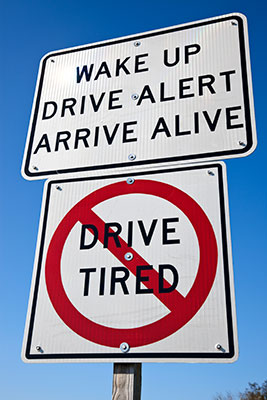Sleeping on the job will get most people fired. For long-distance truckers, it can get people killed.
Chronic fatigue is a rampant problem in the long-haul industry, with deadly consequences and few viable answers.
Limited options for safe, long-term parking is also an issue, forcing drivers to carry on bleary-eyed, or otherwise choose less desirable places to spend the night.
Tired truckers are susceptible to danger regardless of which route they take to deal with the matter. Driving through exhaustion is not only illegal after long stretches, but can lead to fatigue-induced accidents. On the other hand, pulling over to rest in non-designated areas can put drivers at risk of being hit, robbed—or worse.
While some government action has been taken to address the issue, solutions are often slow to materialize and come mostly piecemeal, despite the best nationwide efforts.
With a shortage of qualified drivers—and a rise in delivery demand—fewer professional motorists are tasked with a greater number of miles, and many are left with little choice but to keep on trucking, despite the peril it presents.
No Rest for the Weary

Fatigue behind the wheel has long been connected to dangerous driving. Indeed, there have been government regulations about the issue for as long as there’s been a highway system. (Many rest stops along the country’s interstates are federally mandated, a requirement found in the Federal Highway Act of 1956, the first piece of legislation tackling national roadway safety.)
Rules for long-distance trucking have also long been in place. Currently, the Federal Motor Carrier Safety Administration (FMCSA) dictates drivers must take at least one 30-minute break for every 8 hours of driving, and can drive no more than 11 hours per day and 70 hours per week.
But even when drivers follow such protocol, long-term burnout and exhaustion abound, built over long years of brutal schedules. And the matter is more than an industry occupational hazard—it’s a public health issue, with accidents on the job not just endangering truck drivers, but anyone else on the road.
A July study conducted in Oregon found that one 290-mile stretch of highway in the state alone saw almost $75 million in “crash harm” over the course of seven years. The number includes the combined cost of lost lives, medical bills, and material losses from the accidents, all caused by truck drivers, most suffering from fatigue.
There’s a definite link between roadway weariness and crash harm, said Salvador Hernandez, the study’s lead researcher.
“This is a big issue, and if we don’t do anything, there’s that potential for increased crash harm,” he said. “Now it’s about, what can we implement to reduce the issue?”
Several key factors play a role in the likelihood of crashing, including the time of day, day of the week, lighting and road conditions, and, increasingly, distracted driving, Hernandez said. But another unquestionable consideration is the lack of safe parking spaces for drivers, he added.
“They’re driving for hours and trying to find a place just to park and rest, but sometimes lots are full—sometimes public or private areas, like Pilot gas stations or private industry parking locations may be full,” he said. “It’s a challenge. Where else do they have the opportunity to park besides the side of the road, or off-ramps or on-ramps? And if we do nothing, could that in any way impact the safety on everybody—on all road users?”
At least one study, conducted by the FMCSA in 2014, points in that direction, finding that for every truck driver death, six others—including fellow motorists, cyclists, and pedestrians—died in truck crashes. That same year, a separate study on commercial driver fatigue determined truckers were 12 times more likely to die on the job than other workers in the U.S.
The biggest impact on driving performance wasn’t just how much truckers slept, but when they slept, according to the second study. (The hours between 1 a.m. to 5 a.m. were deemed the most crucial for restful sleep.)
Still, even if a driver manages to sleep through that timeframe, without a safe place to stop, they won’t be able to rest easy, as pulling off on the side of the road brings its own set of risks.
Not Resting in Peace
It was March of 2009 when Jason Rivenburg found himself in need of a place to sleep.
Jason Rivenburg was attacked at an abandoned gas station, robbed, and murdered over the $7 he had in his wallet.
A veteran truck driver of 14 years, the husband, father, and expectant father of twins, had picked up a last-minute load to help out a friend with a shipping business.
The route took him from his home state of New York to Virginia, and then to South Carolina, where, arriving early, Jason decided to stop for the night until his delivery location opened in the morning.
With no other available places to park, he settled on an abandoned gas station, located about 12 miles from the delivery stop, which he had heard from others in the industry was a safe place to stay. Tragically, that night it wasn’t.
Jason was attacked at the location, robbed and murdered over the $7 he had in his wallet. (His wife Hope would give birth just 13 days later.)
The terrible incident led Hope to action, mobilizing friends and family to raise awareness of the parking shortage to those in the trucking industry, and eventually, to Congress. The result of her hard work was Jason’s Law, a 2012 piece of federal legislation requiring more government action and oversight on the issue.
A Federal Highway Administration (FHWA) study conducted in the wake of the measure’s passage, found the parking problem to be “widespread and, at least in some geographic areas, acute.”
Other studies performed since the law was adopted have also confirmed the issue, finding, among other data, that 39% of drivers take one hour or longer to find long-term parking, 49% regularly use places other than designated rest stops to sleep, and 88% felt unsafe while parked for a mandatory rest at some point in the previous year.
To deal with the issue specifically, the Federal Highway Administration formed a spinoff organization, the National Coalition on Truck Parking, in 2015.
“Truck parking has been a focus of FHWA,” organization spokeswoman Nancy Singer wrote in an email. “FHWA has spearheaded the National Coalition on Truck Parking—which brings together stakeholders from state departments of transportation, the freight industry and other transportation organizations and trucking groups to advance safe truck parking.”
But the group—along with the FHWA, which oversees many parking-related initiatives—will have its hands full. By 2020, more than 190,000 long-haul truckers will need to find safe parking every day, according to projections in the FHWA study. That figure marks a rise from the 173,000 drivers noted in the 2012 report.
And expanding the number of spaces isn’t necessarily a simple solution.
Planning for most long-term truck lots took place decades ago, and while the rest areas were designed as parking oases in otherwise unpopulated areas, over the years, the land has filled in around them, making the lots much busier—or leading to their removal all together.
The FHWA also has a comparatively tiny budget for parking-related expenses, according to its report, although Jason’s Law has appropriated some additional federal funds for the matter. (In 2012, the FHWA had $2.9 million in available grant money for parking projects, and received requests from states totaling more than $49 million.)
While the issue may not have budgetary priority, the agency is hoping it can find other ways to solve the problem.
A Hopeful Future
Last year marked an important milestone for the National Coalition on Truck Parking. The fledgling organization held its first round of regional meetings on the topic of the truck parking shortage.
The idea, according Singer, is to collaborate nationally to find better ideas and solutions to the problem by sharing information, data, and new analyses, encouraging partnerships that could help create more parking spaces for truckers, and identifying new and existing programs to support the effort.
And the group has proved ambitious, forming a long list of areas to address, from parking capacity, to funding and finance regulations, to technology and data. (So far, the coalition is operating under the assumption that trucks will be driven by humans for some years yet, as the parking problem will persist until the day autonomous semis take over the roads.)
Still, it’s going to take more than raw ideas to move the needle of progress, said Darrin Roth, spokesman for the American Trucking Associations—a member of the coalition.
“There’s no one solution that’s going to fix the problem,” he said. “It’s going to take a whole lot of different strategies to address this issue, but I think what’s been missing, and hopefully what the coalition will be able to provide, is leadership.”
